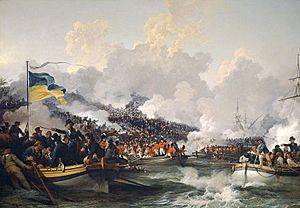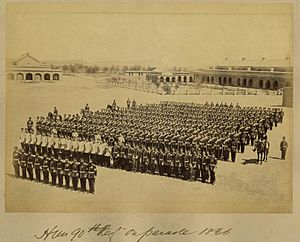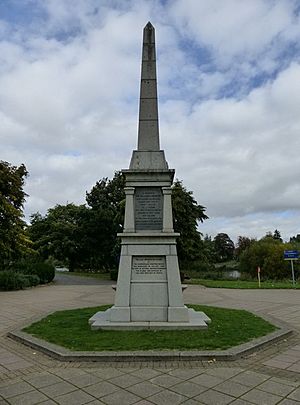90th Regiment of Foot (Perthshire Volunteers) facts for kids
Quick facts for kids 90th Regiment of Foot (Perthshire Volunteers) (Light Infantry) |
|
|---|---|
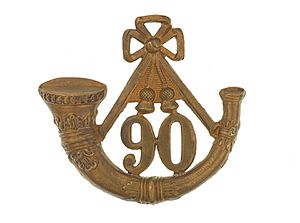
Cap badge of the 90th Foot in the National Army Museum
|
|
| Active | 1794–1881 |
| Country | |
| Branch | |
| Type | Light Infantry |
| Size | One battalion (two battalions 1794–1795 and 1804–1817) |
| Garrison/HQ | Hamilton Barracks |
| Nickname(s) | "Perthshire Grey Breeks" |
| Colours | Buff facings |
| Engagements | French Revolutionary Wars Napoleonic Wars Crimean War Sepoy Revolt Xhosa Wars Anglo-Zulu War |
| Commanders | |
| Notable commanders |
Thomas Graham, Lord Lynedoch |
The 90th Perthshire Light Infantry was a special Scottish army group. They were known as 'light infantry' because they moved quickly. This group started in 1794. Later, in 1881, they joined with another group, the 26th (Cameronian) Regiment of Foot. Together, they became the Cameronians (Scottish Rifles).
Contents
History of the 90th Regiment
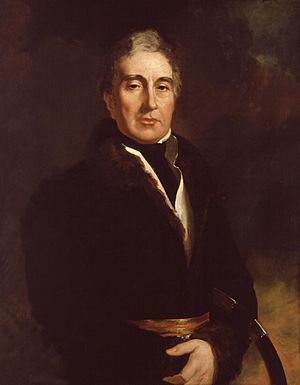
How the Regiment Started
The 90th Regiment of Foot began in Scotland in 1794. A man named Thomas Graham created it. He wanted to help protect Britain from the French Revolution. Graham made sure his soldiers were trained as 'light infantry'. This meant they were fast and flexible.
Their first big mission was in France in 1795. They helped capture an island called Île d'Yeu. Later, they went to Minorca in 1798 and then to Malta in 1800. In 1801, they traveled to Egypt. There, they fought in battles like the Battle of Abukir. After these battles, they returned to England in 1802.
Fighting in the Napoleonic Wars
In 1802, the regiment changed its name to the 90th Regiment of Foot (Perthshire Volunteers). They even added a second group of soldiers in 1804. This second group stayed in the United Kingdom.
The first group went to the West Indies in 1805. They were stationed on Saint Vincent. They fought in the invasion of Martinique in 1809. They also took part in the invasion of Guadeloupe in 1810.
In 1814, the soldiers sailed to Canada. They were based in Quebec during the War of 1812 against the United States. In 1815, their name changed again to 90th Regiment of Foot (Perthshire Volunteers) (Light Infantry). They went to France in 1815 as part of the army that occupied the country after the Napoleonic Wars. In 1817, the two groups of soldiers joined back into one.
The Victorian Era and Later Battles
The regiment traveled a lot during the Victorian era. They were in Malta and the Ionian Islands in the 1820s. In 1835, they went to Ceylon for ten years.
After that, they sailed to South Africa in 1846. There, they fought in the Seventh Xhosa War. In 1854, they went to Balaklava and fought in the Siege of Sevastopol during the Crimean War.
In 1857, the regiment went to India. They helped stop the Indian Rebellion. They were part of the important relief of Lucknow in 1857. During this battle, six soldiers from the regiment earned the Victoria Cross. This is the highest award for bravery in the British military.
The regiment returned to South Africa in 1878. They fought in the Ninth Xhosa War. They also took part in the Anglo-Zulu War in 1879. They fought in battles like Battle of Kambula and Battle of Ulundi. Later that year, they went back to India.
Finally, in 1881, the 90th Regiment joined with the 26th (Cameronian) Regiment of Foot. This was part of a big army change called the Childers Reforms. Together, they became the Cameronians (Scottish Rifles).
Battle Honours
Battle honours are special awards given to military units for their bravery in battles. Here are some of the honours won by the 90th Regiment:
- Napoleonic Wars: Mandora, Egypt, Martinique 1809, Guadeloupe 1810
- Crimean War: Sevastopol
- Indian Mutiny: Lucknow
- South Africa 1846–72, South Africa 1877-79
Victoria Cross Heroes
The Victoria Cross (VC) is the highest award for bravery in the British armed forces. It is given for extreme courage in the face of the enemy. Here are some of the brave soldiers from the 90th Regiment who received this medal:
- Private John Alexander, for bravery in the Crimean War (1855)
- Sergeant Andrew Moynihan, for bravery in the Crimean War (1855)
- Lieutenant William Rennie, for bravery in the Indian Mutiny (1857)
- Surgeon Anthony Dickson Home, for bravery in the Indian Mutiny (1857)
- Assistant surgeon William Bradshaw, for bravery in the Indian Mutiny (1857)
- Major John Christopher Guise, for bravery in the Indian Mutiny (1857)
- Sergeant Samuel Hill, for bravery in the Indian Mutiny (1857)
- Private Patrick Graham, for bravery in the Indian Mutiny (1857)
- Private Edmund Fowler, for bravery in the Anglo-Zulu War (1879)
- Lieutenant Henry Lysons, for bravery in the Anglo-Zulu War (1879)
Commemorations
There is a tall monument, like a stone pillar, in Perth, Scotland. It remembers the 90th Regiment. It was revealed in 1896. One of the plaques on it says:
The Regiment served with distinction at Mandora 1801, Martinique 1803, Guadeloupe 1810, in America 1814–5, South Africa 1846–7 and 1878–9, Crimea 1854–6, Indian Mutiny 1857–8 and on 1st July 1881 was formed into the Second Battalion The Cameronians (Scottish Rifles)
Another plaque on the monument mentions:
The last Regular Battalion of the Cameronians (Scottish Rifles) was disbanded on 14th May 1968 as part of national defence economies


